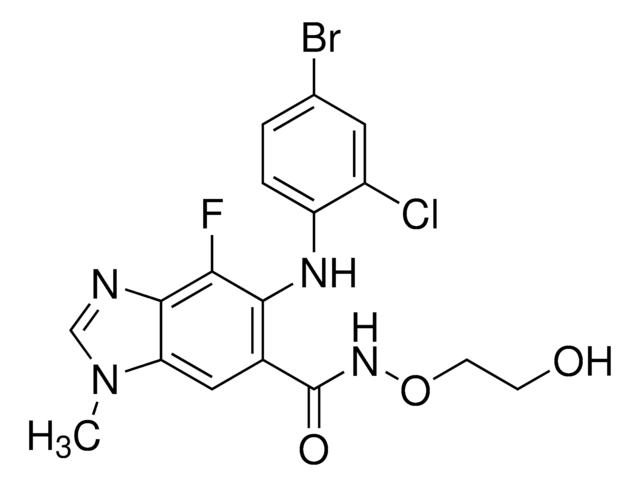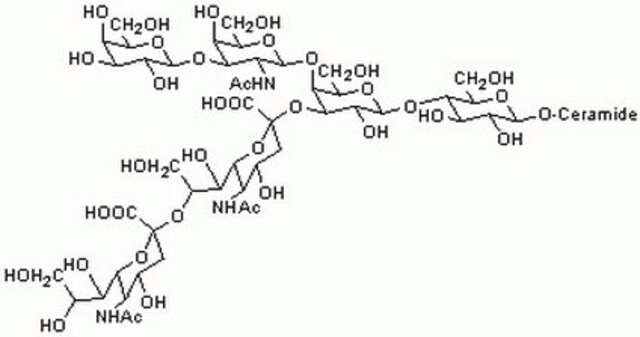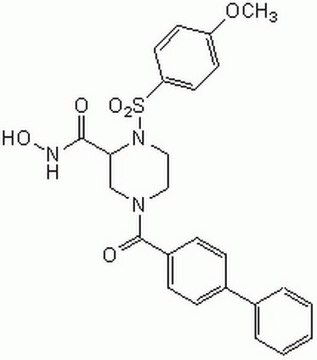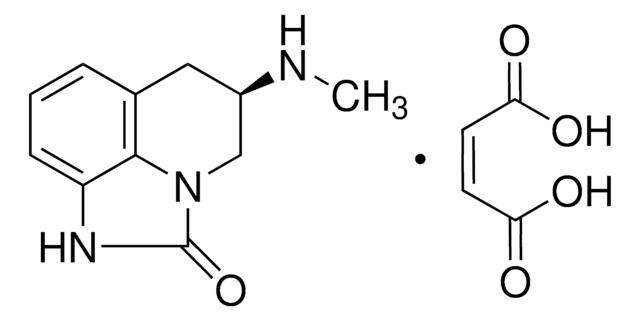444283
MMP-13 Inhibitor
The MMP-13 Inhibitor, also referenced under CAS 544678-85-5, controls the biological activity of MMP-13. This small molecule/inhibitor is primarily used for Protease Inhibitors applications.
Synonim(y):
Kwas pirymidyno-4,6-dikarboksylowy, bis-(4-fluoro-3-metylo-benzyloamid)
About This Item
Polecane produkty
Poziom jakości
Próba
≥98% (HPLC)
Formularz
solid
producent / nazwa handlowa
Calbiochem®
warunki przechowywania
OK to freeze
protect from light
kolor
light yellow
rozpuszczalność
DMSO: 10 mg/mL
Warunki transportu
ambient
temp. przechowywania
2-8°C
ciąg SMILES
Fc1c(cc(cc1)CNC(=O)c2ncnc(c2)C(=O)NCc3cc(c(cc3)F)C)C
InChI
1S/C22H20F2N4O2/c1-13-7-15(3-5-17(13)23)10-25-21(29)19-9-20(28-12-27-19)22(30)26-11-16-4-6-18(24)14(2)8-16/h3-9,12H,10-11H2,1-2H3,(H,25,29)(H,26,30)
Klucz InChI
PYFRREJCFXFNRR-UHFFFAOYSA-N
Opis ogólny
Działania biochem./fizjol.
MMP-13 activity
Opakowanie
Ostrzeżenie
Uwaga dotycząca przygotowania
Rekonstytucja
Inne uwagi
Informacje prawne
Kod klasy składowania
11 - Combustible Solids
Klasa zagrożenia wodnego (WGK)
WGK 1
Temperatura zapłonu (°F)
Not applicable
Temperatura zapłonu (°C)
Not applicable
Certyfikaty analizy (CoA)
Poszukaj Certyfikaty analizy (CoA), wpisując numer partii/serii produktów. Numery serii i partii można znaleźć na etykiecie produktu po słowach „seria” lub „partia”.
Masz już ten produkt?
Dokumenty związane z niedawno zakupionymi produktami zostały zamieszczone w Bibliotece dokumentów.
Powiązane treści
Wybierz różne typy inhibitorów proteaz w zależności od potrzeb, aby zapobiec degradacji białek podczas izolacji i charakteryzacji oraz zabezpieczyć białka podczas przygotowywania próbek.
Nasz zespół naukowców ma doświadczenie we wszystkich obszarach badań, w tym w naukach przyrodniczych, materiałoznawstwie, syntezie chemicznej, chromatografii, analityce i wielu innych dziedzinach.
Skontaktuj się z zespołem ds. pomocy technicznej
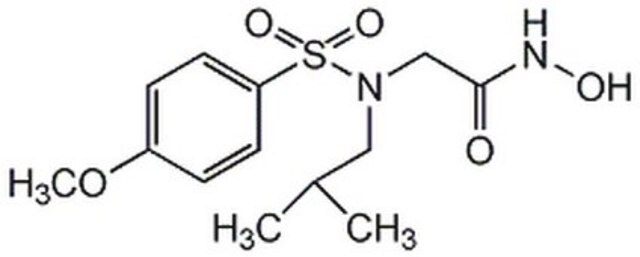

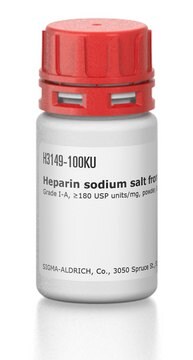
![Guanosine 5′-[γ-thio]triphosphate tetralithium salt ≥90% (contains < 10% GDP, HPLC), powder](/deepweb/assets/sigmaaldrich/product/structures/131/514/e3025b6a-cb52-4818-b20f-98efac485c1a/640/e3025b6a-cb52-4818-b20f-98efac485c1a.png)
